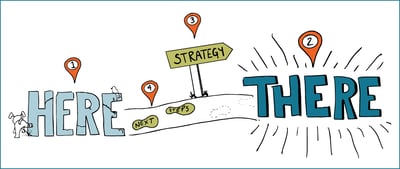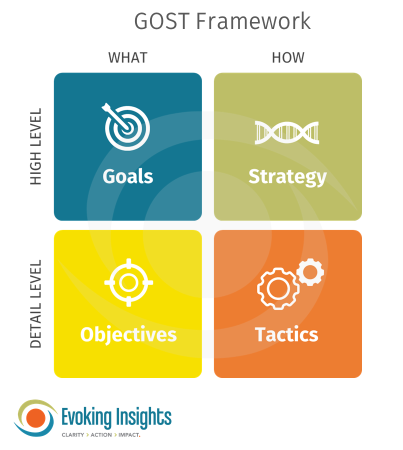“At last—now I know how to decide which M&A targets to pursue and which to forego.”
So said Ava, a strategy coaching client. She was beaming ear‑to‑ear with confidence to make those strategic decisions. Her energy and sense of momentum were palpable. The fog had lifted, and the focus of the organization was now clear as day. I let her ride the high of this milestone… for now.
Before starting our work together, Ava had felt overwhelmed when faced with those decisions. She had plenty of key inputs, including market analysis, revenue projections, and a logic as to why this deal might be a good fit. What she had been missing was a clear point of view on where the business as a whole was headed—a strategic basis for her decisions.
At its most fundamental level, strategy is as simple as outlining the following:
- Where are you NOW? This is your current state (internal and external landscape).
- Where do you want to BE? This is your desired future state.
- How will you GET there? This is the pathway from here to there.

Ava couldn’t articulate her “there” when we started our work together. She also couldn’t articulate the pathway or… Wait, what is strategy again?
Quickly, the simple strategy cartoon unravels into complexity. One definition of strategy orients around that same question Ava had struggled to answer: “Where is the business headed?”
“Strategy is a general direction set for the company and its various components to achieve a desired state in the future”
The metaphor of direction is common in strategy. I often use it with clients — are we heading North or South? Perhaps because it helps to make the abstract feel more concrete.
Well‑known strategy guru Michael Porter says a strategist’s job is to get the organization in the right quadrant. Meaning, on a 2x2 grid, which quadrant have we narrowed our focus and direction into — e.g., Northwest or Southeast?
Great! But like Ava asked in our first meeting, “So how exactly do we do that?”
Path A: Financial / Objective‑Driven
Many executives will define “There” by outlining financial objectives. Being tangible and measurable provides a clear target — “We want to be $X Billion in revenue, market valuation, profit.” Sometimes market or financial goals will be restated as strategic directions — “To be the market leader” or “To accelerate top‑line growth.”
But these statements don’t provide strategic clarity. The GOST framework helps reveal the gap.

Both expressions of “There” are anchored in the “What are we trying to achieve?” — one broader and more general (goal), one with more specificity (objective).
Goal: Become the market share leader
Objective: Grow segment market share to over 40% by 2022.
Either way, if we stop at “Be the market leader,” there isn’t sufficient clarity of direction to inform next-level decisions that must happen along the way. It is a goal likely held by all our competitors. And there are many ways to achieve that goal. More specificity is required to keep the organization aligned in action to a common direction.
And yet, this is where leaders can get into trouble. Particularly at Stage 2 of the journey to Game‑changing strategic leadership when strategic plans provide that clarity of action through key initiatives. Since we can’t see or physically touch strategic direction, it’s often skipped in favor of going straight to the specificity of tactics. Action plans that too often list goals, objectives, and tactics — skipping strategy altogether.
With this kind of tactical specificity, teams gain clarity of action, but they lack clarity of direction.
Like Ava, they are left with no strategic basis to decide where to focus resources for greatest impact. When we outline “tactics” and specific growth initiatives to achieve a financial objective, everyone will be terribly busy — but to what end? Your organization will lack aligned actions that cohesively work together to create sustainable value and advantage at the organizational level. You miss the opportunity to position the business for the future.
With no strategy in place, any idea that will make money or accelerate growth is a viable option. The problem is, you will end up with many great leaders all pulling the organization in slightly different directions. Instead of unlocking the power of collective effort, like a rowing team, everyone is taking a slightly different path. And you will begin to hear from your employees — “Where are we trying to go?” They can’t see what all the activity adds up to because it doesn’t represent a set of clear and integrated choices.
Clarity of direction, in the form of those high‑level choices and approach to achieve the goal, enables aligned and reinforcing action. Only strategy can bring that clarity of direction.
Path B: Destination / Position‑Driven
Strategy needs to place us somewhere in the future. “There” is a destination. Different than a goal. It is somewhere to go, not something to achieve. It is less about doing, and more about becoming.
I can write every week, with a goal to write and publish an article every two weeks — and still not BE a writer. True of many things — tell a joke and not be a comedian, run a science experiment and not be a scientist... the distinction of DOing versus BEing. One is action. The other is essence — intangible, unique, hard to describe, and difficult to replicate. While essence is expressed in action, you can have action without essence.
A strategist’s job is to create, differentiate, and position for the future. To build an organization in a way that creates distinct value for customers AND is difficult for competitors to replicate is the holy grail of strategy. We have a better chance of achieving that holy grail when we decide who the organization needs to become to be well‑positioned for an envisioned future.
I get it. Becoming can feel quite abstract. It feels conceptual because it is — we are conceiving, creating. My wiring allows me to feel more comfortable with that. Others have a bias for the concrete and will struggle, asking — “Ok, but what does that mean in practice?” The answer lies at the intersection of these two perspectives — conceptual AND concrete. Without specificity of action, that future won’t be realized. Without the clarity of direction, action cannot be aligned to a shared future.
The first practical step is to shift your mindset to orient around a destination. The destination of strategy is a position in the market‑of‑the‑future that allows you to win with your customers, relative to the competition. That requires:
- A clear point of view about that future market — what will be different from today?
- A systems perspective — operating at the organizational level to make 1 + 1 = 3
- An integrated set of strategic choices that are cohesive and synergistic
For Ava, we laid out options for where the business could head — each representing a distinct strategic endpoint. We used the Play‑to‑Win framework to tangibly describe the options — each an integrated set of choices about where the business would play (e.g., markets, products, geographies, customer needs) and how they would win relative to competition through a distinct set of capabilities. We narrowed the endpoints down to three options:
- Diabetes Expert focused on diabetes research, medicine, and care
- Early‑Stage Research Expert focused on developing molecules and formulations
- Go‑To‑Commercialization Partner focused on turning the best scientific advances into effective new drugs (In other words, be the commercialization engine for early‑stage science players.)
You can easily see these as different destinations. Each realized with different capabilities and priority areas of focus. Ava could easily see that the options were cohesive and synergistic. The clarity of what the firm should and shouldn’t do was evident. In fact, this is a litmus test of the options we created: If they don’t guide clear decision-making, then we haven’t done our job.
Again and again, I have witnessed the strategic clarity that emerges for clients after going through this process. The lifting fog and resulting confidence to make these high‑stakes decisions is common and powerful. As with Ava, suddenly decisions that had been hard to make became crystal clear. And the strategic basis for future decisions is now clear.
By taking the time to think through the different strategic directions and supporting logic, clients gain the confidence to make not only these tough calls but also the many next‑level strategic decisions that will emerge along the way.
Ava felt fantastic. And… I had to break it to her that this strategic clarity was just the beginning. Now we needed to translate that robust strategic thinking into aligned strategic action.
Bridging the Paths
Here is the maddening part about strategy: The only way for Ava to communicate and manifest this strategic clarity is in the form of strategic imperatives — a.k.a., goals. The “what you need to achieve.” Clarity of focus will need to be translated into objectives so there is specificity and an ability to measure success.
That means next‑level strategy and planning needs to occur on how to achieve those objectives. Decision‑making, choice, and specificity continue to unfold as strategy cascades through the organization.
The goal: aligned organizational action toward a shared vision of the future.
The larger the organization, the greater the risk that next‑level decisions start to pull the organization in different directions.
In making strategy concrete and actionable, we risk losing visibility to the why behind the strategic focus. The strategic logic behind our narrowing choices. If we have done our jobs well, people will see how the imperatives are synergistic. And the more they understand the strategic logic behind our choices, the more likely those next‑level choices will continue to propel everyone in the same direction.
And therein lies the art of strategic leadership — aligning short‑term actions with long‑term direction.
We are continually iterating between the directional and the specific through a cascading set of decisions.
Ava now knows her “There” and how to articulate it through strategic decision‑making. She took the time to engage in robust strategic thinking and make high‑stakes decisions that take options off the table. That’s worth celebrating. AND, our work now is to bridge that clarity of long‑term direction with clarity of near‑term action. To get everyone rowing in the same direction.
Strategy isn’t as simple as making a few key decisions and then fast‑forwarding through implementation. It is an ambiguous, emergent practice of becoming. But only through seeing the business as a whole — today, and in the envisioned future reached through a series of cascading actions — can the holy grail of strategy be achieved:
To build an organization in a way that distinctly creates value for customers AND is difficult for competitors to replicate.



